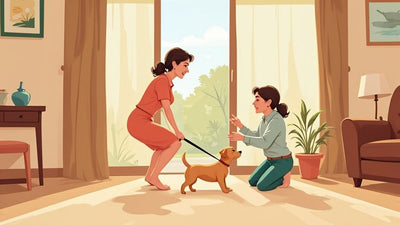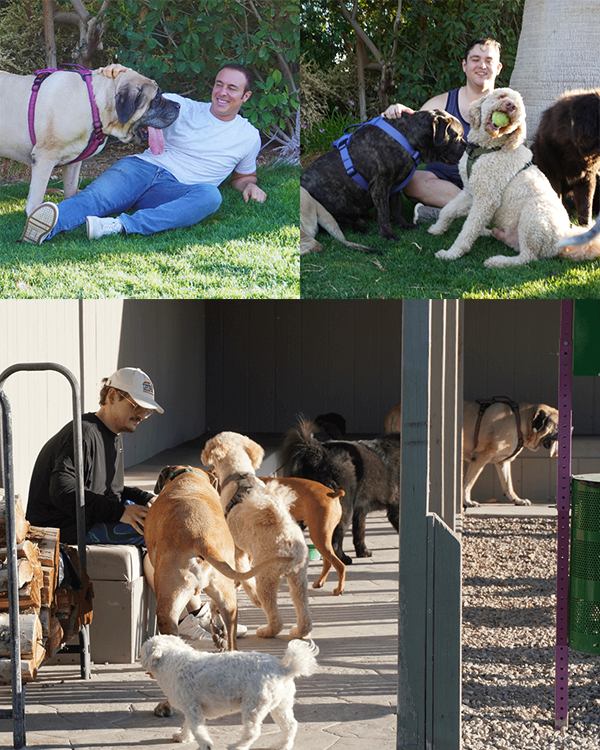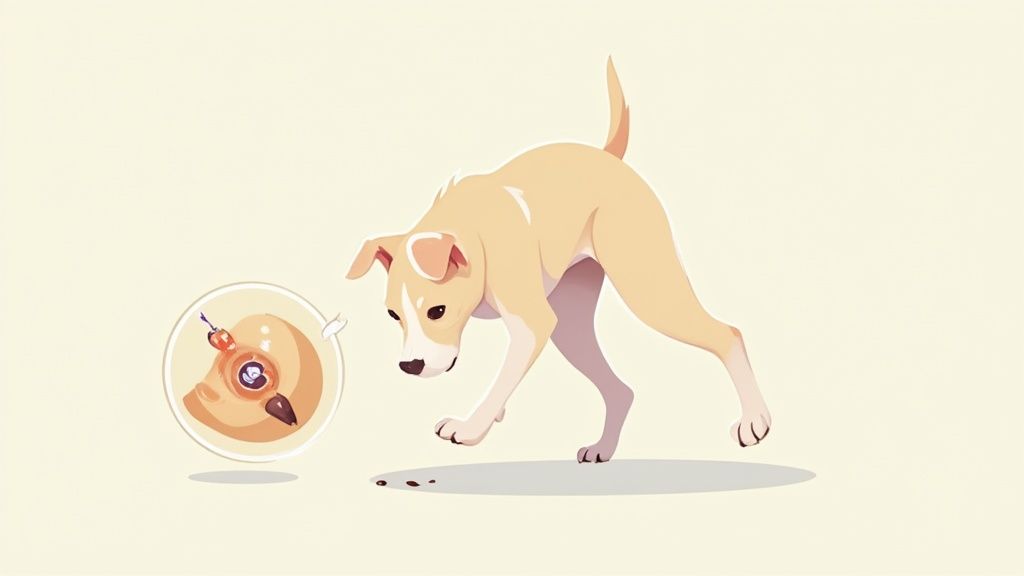
A Guide to Vestibular Disease in Older Dogs
It can happen in the blink of an eye. One moment, your senior dog is fine; the next, they suddenly can't stand up, their head is cranked to one side, and their eyes are darting back and forth. This is the classic, and often frightening, presentation of idiopathic vestibular disease. We know how upsetting it is to witness, and understanding what’s happening is the first step on the journey to getting your companion back on their paws.
That Frightening Moment Your Dog Seems Lost
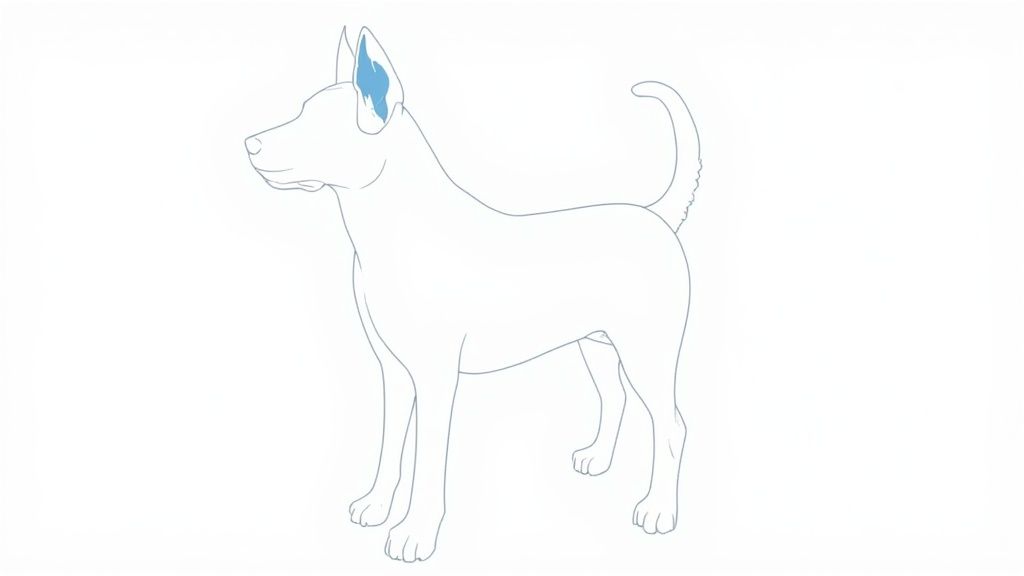
We get it—the panic that floods you is immense. Your dog seems totally lost, unable to get their bearings. It’s a scene that sends countless loving pet parents straight to the emergency vet, thinking the worst, like a stroke. If you've been there, you're not alone.
This abrupt loss of coordination is the signature of what many call "old dog vestibular disease." The best way to think about your dog's vestibular system is as their built-in gyroscope. Located in the inner ear and brain, it controls their balance and tells them which way is up.
When that system suddenly goes on the fritz, it's like being trapped on a violently spinning carnival ride they can't get off of. The world is tilting and spinning, and they have no idea why.
Recognizing the Common Signs
The symptoms are dramatic, but learning to identify them can help you stay calm and focused. Your observations are a crucial support for your veterinarian, so knowing what to look for is a huge help.
"The moment it happens is so scary. But the high likelihood of rapid improvement can be a beacon of hope. For most dogs, more good days are on the horizon."
These signs often appear out of nowhere. Here's a quick guide to what you might see during a vestibular episode.
Quick Guide to Common Signs of Vestibular Disease
| Symptom | What You Might See |
|---|---|
| Head Tilt | A sudden, pronounced, and persistent tilt of the head to one side. |
| Loss of Balance (Ataxia) | Stumbling, swaying, leaning, or falling over completely. They may struggle to stand up. |
| Nystagmus | Rapid, uncontrolled eye movements, either side-to-side, up-and-down, or in a circle. |
| Circling | Walking in tight circles, almost always in the same direction as the head tilt. |
| Nausea and Vomiting | The intense dizziness often causes a loss of appetite, drooling, and sometimes vomiting. |
Remember, as alarming as this looks, these are the textbook signs of a vestibular problem. This isn't a failure on your part as a pet parent; it's just one of the health journeys that can come with a long, well-loved life. Take a deep breath, observe carefully, and know that you’ve already taken the most important step toward helping them recover.
Get Your FREE Dog Brain Health Guide

Get instant FREE access to today's top ways to help your best friend live a longer, healthier, happier life.
- 39 value-packed pages of expert insights
- Early-detection tips for cognitive decline
- Top brain-boosting superfoods
- Vet-approved mental sharpness strategies
- Fun IQ tests for your dog
Understanding Your Dog's Inner Compass
To really grasp what's happening to your dog, think about their vestibular system. Tucked away deep inside the inner ear and brain, it acts like their personal navigation center. This intricate network is constantly working, telling them which way is up and how their body is positioned—it’s their own internal compass.
When this system goes on the fritz, that reliable sense of stability vanishes. For your dog, it must feel like being stuck on a boat in a violent storm. It's incredibly disorienting. Getting to the bottom of what's causing this "storm" is the very first step in helping them get back to calm waters.
This infographic breaks down the two main types of vestibular disease, giving you a clearer picture of where the problem might be starting.
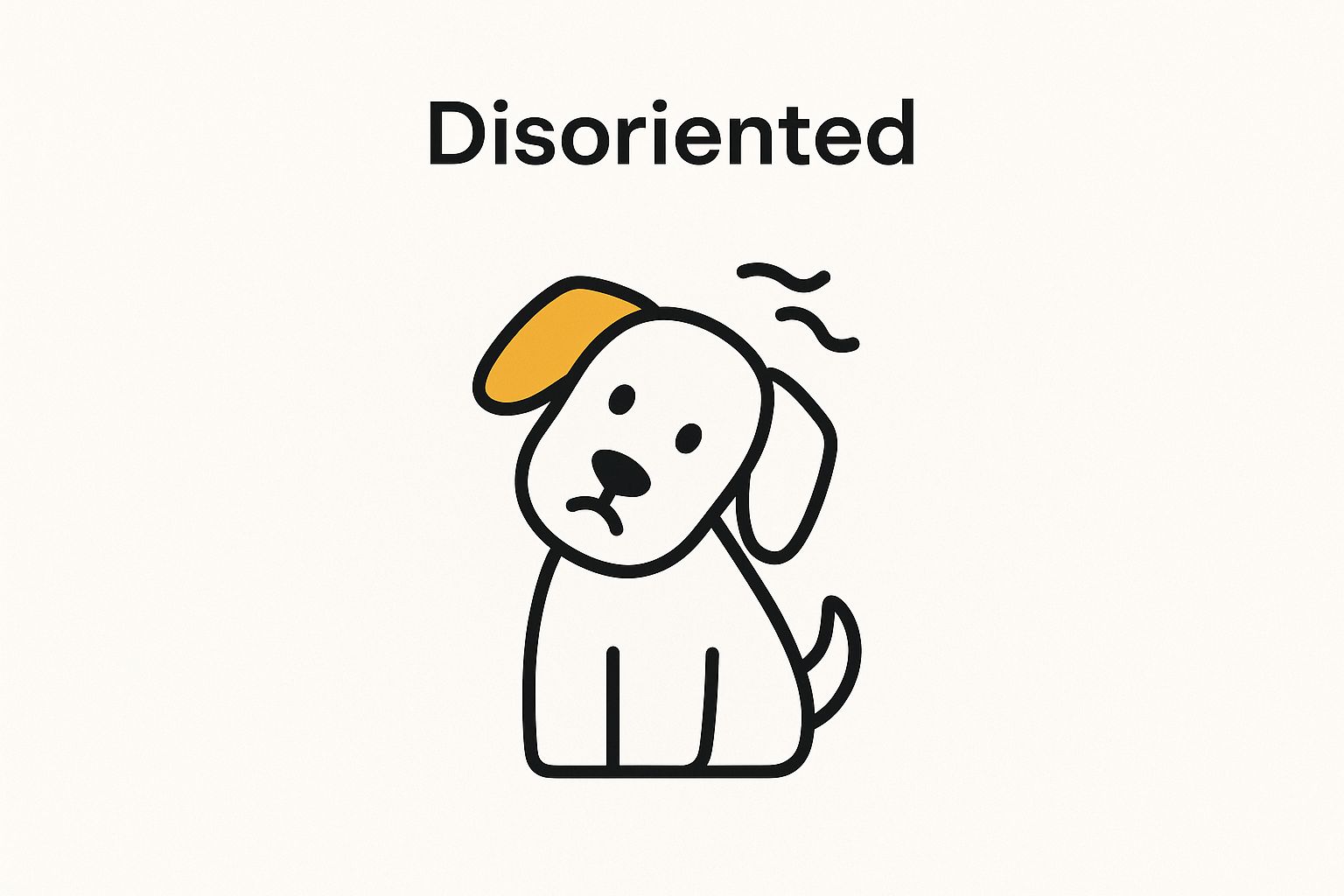
As you can see, the overwhelming majority of cases in older dogs start in the inner ear. That's usually very good news when it comes to their recovery journey.
Two Paths of Disruption
Even though the symptoms can look frighteningly similar, the problem usually stems from one of two places. Knowing the difference can help you understand what lies ahead.
-
Peripheral Vestibular Disease: This is, by far, the most common type we see, especially in what's known as "old dog syndrome." The problem is located in the nerves of the inner ear, which means it’s outside the brain itself. Think of it like a broken sensor on a ship's gyroscope—the central computer is working just fine, but it's receiving faulty data.
-
Central Vestibular Disease: This form is much less common but more serious. Here, the issue is actually inside the brainstem, which is a core part of the central nervous system. To go back to our ship analogy, this is like the main navigation computer itself having trouble processing the signals correctly.
We know hearing words like "brainstem" is scary. But remember, peripheral vestibular disease is much, much more common in senior dogs, and so many of them bounce back beautifully with a little help and time. On this journey, every small improvement is a huge win.
While these dizzy spells can happen at any age, they become much more frequent as our dogs enter their golden years. The average age for a diagnosis is over 12 years old. In fact, the chances of a senior dog experiencing an episode jump up significantly after they turn nine. You can read more about the research on age-related risk from the RVC.
Only your veterinarian can figure out the true cause. But having this background knowledge can help turn your fear into focused observation, which makes you the best possible advocate for your dog's care.
Recognizing the Signs and Potential Causes
You know your dog better than anyone. You're the first to spot those tiny shifts in their routine or the slight changes in how they carry themselves. That intuition is your most powerful tool, especially when dealing with something as bewildering as vestibular disease.
The really dramatic signs—a sudden, severe head tilt or a drunken-like stagger—are impossible to miss. But sometimes, the clues are much quieter. These subtle hints are often just as crucial for understanding what your old friend is going through.
Beyond the Obvious Symptoms
It’s natural to focus on the most alarming behaviors, but a vestibular episode can throw your dog’s entire world off-kilter in ways that aren't immediately obvious. Picking up on these smaller signs will help you comfort them and give your vet a much clearer picture.
Keep an eye out for these subtle shifts:
- Not wanting to eat or drink: Imagine feeling like the room is spinning. Now, try bending down to a bowl on the floor. It often makes the dizziness and nausea a whole lot worse. It’s not necessarily a loss of appetite, but an attempt to avoid that awful sensation.
- Odd sleeping habits: You might find your dog wedging themselves into a corner or pressing tightly against the sofa to sleep. This isn't just a new quirk; they're trying to feel more stable and grounded when their inner balance system has gone haywire.
- Hiding or sudden clinginess: Feeling dizzy and disoriented is genuinely frightening. Depending on their personality, your dog might seek out a dark, quiet spot to hide away or, conversely, become your shadow, looking to you for reassurance.
These behaviors, especially when they pop up alongside the more classic symptoms, help fill in the gaps. It's easy to mistake some of these for other issues that come with age. We cover more of this in our guide to common aging dog behavior changes.
Uncovering the Common Causes
One of the first questions every dog owner asks is, "Why did this happen?" For most older dogs with vestibular disease, the answer is a bit unsatisfying: we don't know. This is called idiopathic vestibular disease, and it's by far the most common diagnosis, meaning it just happens without any clear cause.
It’s completely normal to want a concrete reason. But an "idiopathic" diagnosis is actually good news. It means your vet has likely ruled out more serious problems, and you can focus entirely on helping your dog feel better.
While idiopathic cases are the most frequent, your vet will still look for other potential culprits. Things like deep inner ear infections, a reaction to certain medications, or other underlying health issues can also throw the vestibular system into a spin.
Historically, the idiopathic form is the leading cause of these balance issues. One study highlighted just how common the main symptoms are, noting a head tilt in over 98% of dogs, loss of balance in 65%, and rapid, darting eye movements in 52%. You can dive deeper into the science in this in-depth clinical study on vestibular dysfunction.
Navigating the Veterinary Diagnosis Process
It’s completely understandable to feel overwhelmed when you walk into the vet’s office with your best friend looking so dizzy and lost. The fear of not knowing what’s wrong can be incredibly heavy. Let’s walk through what you can expect during the visit, so you can feel more prepared and a little less anxious.
Think of the diagnostic process as a partnership between you and your vet. It all starts with a conversation and a gentle, thorough examination. Your vet is essentially a detective, searching for specific clues to figure out what’s going on inside your dog’s balance center.
The Initial Physical and Neurological Exam
The first step is a hands-on assessment of your dog’s overall health. Your veterinarian will look your dog over from nose to tail, paying special attention to their ears for any signs of infection that could be triggering the dizziness.
Next, they’ll move on to a neurological exam. This is the key to determining if the problem is in the inner ear (peripheral vestibular disease) or rooted in the brain (central vestibular disease). During this exam, your vet will likely:
- Observe eye movements: They’ll look for that classic sign of nystagmus (the rapid, darting eye movements) and carefully note its direction—whether it’s side-to-side, up-and-down, or rotary.
- Check reflexes: A few simple reflex tests help gauge nerve function, which provides more clues about where the problem is located.
- Evaluate coordination: Simply watching how your dog stands, leans, and tries to walk gives the vet a ton of information about the source of the imbalance.
You are a crucial part of this process. Your detailed observations from home—like mentioning your dog is sleeping with their head tilted or leaning against furniture to stay upright—provide invaluable context. This is a team effort.
When Further Tests Are Recommended
For many senior dogs, the physical and neurological exam points strongly toward idiopathic vestibular disease, meaning no other tests are needed. But sometimes, your vet might suggest additional diagnostics to be absolutely sure nothing else is going on. This isn't a reason to panic; it’s just about being thorough.
These tests could include blood work to rule out underlying health issues that might be contributing. In some cases, your vet might recommend advanced imaging, like an MRI. While the initial exam is very insightful, it’s not always foolproof at distinguishing between a peripheral (inner ear) and central (brain) issue.
In fact, research shows that initial neurological exams can sometimes misinterpret the location of the problem. An MRI can give a definitive answer, which is crucial for confirming a diagnosis and ensuring your dog gets the right supportive care. You can learn more about MRI findings in vestibular cases right here.
Every step is designed to bring you clarity, helping you and your vet create the best possible plan to get your dog back on all four paws.

Support Your Dog's Brain Health with NeuroChew™
As mentioned in this article, NeuroChew is the first dog chew designed to support both cognitive function and healthy circulation. Perfect for dogs showing early signs of cognitive decline or for proactive brain health support.
Creating a Safe Space for Recovery at Home
Bringing your dog home from the vet is where your most important job begins. With the diagnosis confirmed, your focus now shifts to their comfort and safety. It’s in these moments that your calm presence and thoughtful care make all the difference in their recovery from vestibular disease.
Your dog’s world is literally spinning, so your first task is to create a small, safe sanctuary for them. The goal is to make their environment feel stable and predictable while their internal compass gets a chance to reset.
Setting Up a Cozy Rest Area
Think of it as building a little recovery nest. Find a quiet spot away from the daily hustle and bustle of your home. A comfortable crate or a corner of a room sectioned off with baby gates works perfectly. This keeps them from wandering and potentially falling.
- Flooring is Key: A dizzy dog on a slippery floor is a recipe for disaster. Hardwood or tile can feel like an ice rink to them. Lay down some non-slip rugs, yoga mats, or carpet runners to give them the traction they desperately need.
- Comfortable Bedding: Choose a low, supportive bed that’s easy to get into and out of. Lots of soft bedding will also help cushion any stumbles or wobbles.
You are their anchor in a spinning world. By creating a calm, predictable space, you're not just providing physical safety—you're offering profound emotional reassurance and helping them feel grounded.
Assisting with Daily Needs
Simple things we take for granted—eating, drinking, or going outside—are now major hurdles. Your hands-on help is absolutely essential to get them through the day and maintain some sense of normalcy.
It’s very common for a dog with vestibular disease to refuse to eat or drink simply because lowering their head makes the dizziness and nausea so much worse. You can easily solve this by bringing their food and water up to them.
Tips for Mealtime and Potty Breaks:
- Elevate Their Bowls: Raise their food and water bowls up to chest height so they don't have to bend their neck down. You can use a dedicated stand, a stack of books, or just hold the bowls for them. Hand-feeding is also a wonderful way to offer comfort and make sure they're getting enough to eat.
- Use a Supportive Sling: Just getting outside for a potty break can feel like an impossible journey. A simple bath towel slung under their belly for support, or a purpose-made mobility sling, can help you keep them steady on their feet. This not only prevents falls but also gives them a huge confidence boost.
These small acts of care are incredibly powerful. By tweaking your home setup and helping with the basics, you’re giving your dog the support they need to get back on their paws, one steady step at a time.
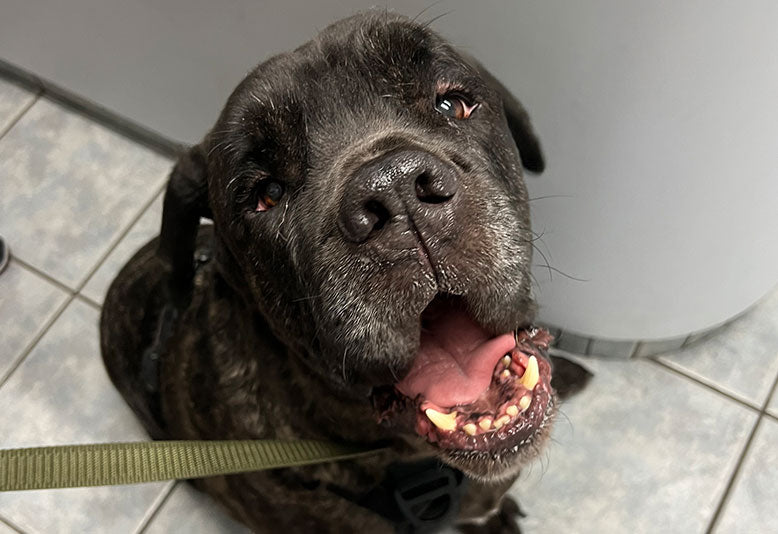
Real Results: How NeuroChew Helped Brutus Regain His Mental Clarity
Brutus was getting disoriented at night. After starting NeuroChew, he's more happy during the day and steady at night. He's back to his old self!
Supporting Your Dog Through the Recovery Journey
Watching your dog suddenly become wobbly and disoriented is incredibly stressful. It’s natural to feel helpless, but your calm presence and support are exactly what your companion needs right now. Remember, this is a recovery journey, and your role is to provide a safe, loving environment for them.
For most dogs with the common idiopathic form of vestibular disease, you’ll likely start to see small improvements within the first 72 hours. Those initial, most dramatic symptoms often begin to fade relatively quickly. Full recovery, however, is a longer road—it can take several weeks, and it truly calls for our patience.
What Does Recovery Look Like?
During this time, your vet will focus on supportive care to make your dog more comfortable. Anti-nausea medication is often recommended, as it directly addresses the dizzying, seasick feeling that can reduce their appetite and make them miserable.
Don't be surprised if your dog keeps a slight head tilt even after they've gotten their paws back under them. It's actually quite common. Think of it less as a lingering problem and more as a little quirk—a badge of honor for the journey they just went through.
"We measure success not in a perfect return to 'normal,' but in peaceful nights, moments of clarity, and a wagging tail. Small improvements can mean everything."
Ultimately, the goal is to help your dog’s entire system recalibrate. This is a great time to focus on their overall wellness, especially their neurological health, to keep them feeling sharp and comfortable in their golden years. Many pet parents find that adding targeted support for cognitive function can be a huge help. A natural supplement like FureverActive's NeuroChew, designed to support brain health, can be a valuable part of their long-term wellness plan, helping them feel more steady and engaged with life again.
And please, be kind to yourself through this. You’re doing an amazing job giving your dog the stability and love they need to feel safe while they find their way back to solid ground.
Your Top Questions About Vestibular Disease
When you're watching your best friend struggle, it's completely normal to have a million questions running through your mind. We understand those 3 AM searches for answers. Let's walk through some of the most common concerns we hear from worried dog parents just like you.
How Long Does Vestibular Disease Last in Older Dogs?
With idiopathic vestibular disease—the most frequent kind in seniors—the most frightening, dramatic symptoms often start improving within the first 72 hours. That initial turnaround can feel like a huge relief.
Most dogs get their sea legs back within two to three weeks, though it's not uncommon for a slight head tilt to stick around as a quirky reminder of their ordeal. Every dog's recovery timeline is a little different, but the scariest part is usually short-lived.
Is Vestibular Disease Painful for My Dog?
The condition itself isn't considered painful in the way a broken bone or arthritis is. However, the experience is incredibly disorienting and distressing for them.
Think about the worst case of vertigo you can imagine—that intense dizziness and nausea is what your dog is feeling. That's why your veterinarian's primary goal is often to manage the nausea with medication and help your dog feel safe and comfortable while their world stops spinning.
You're not alone in worrying about every little thing. The most important step is getting a clear diagnosis from your vet to rule out other issues and create a supportive care plan together.
Can This Happen Again?
Unfortunately, yes, it's possible for a dog to have another episode. While many dogs only go through this once, a recurrence can happen, and there's no way to completely prevent it.
The best approach is to focus on your senior dog's overall wellness through great nutrition, regular vet check-ups, and a supportive environment. This gives them the best possible foundation for long-term health and helps maintain their comfort and clarity through their golden years.
At Furever Active, we believe in supporting your dog's brain health for more good days together. Explore our natural supplements to help maintain their mental clarity and comfort. Find the right support for your loyal companion at https://fureveractive.com.
Share This Article

Support Your Dog's Brain Health with NeuroChew™
The first dog chew that supports both brain function and healthy circulation. Perfect for dogs of all ages.
- Enhances cognitive function & mental clarity
- Reduces anxiety without sedation
- Supports healthy blood circulation
- Made in USA with natural ingredients
60-Day Money-Back Guarantee • Free Shipping





